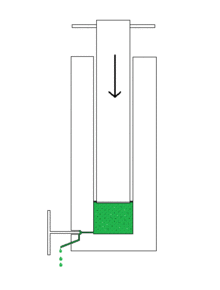French press
The French press (also French pressure cell ) is in the biochemistry apparatus used for cell disruption . It is named after its developer Charles Stacy French . The Manton-Gaulin homogenizer is an enlarged version of the French press.
principle
A suspension of cells is compressed in a pressure vessel with a piston pump to a pressure of 69 to 138 MPa . The pressure chamber has a needle valve with a small opening diameter. When the valve is opened, the previously compressed liquid expands and the resulting shear forces lead to cracks in the biomembranes , ie the cell membrane and the membranes of the cell organelles . Lower pressures of about 6.9 MPa are used to maintain the membranes of the cell organelles. Compared to most other physical digestion methods, the shear forces can be adjusted via the pressures used, and shear only occurs once when passing through the opening, which means that cell structures such as cell organelles and chromosomes are less damaged.
Applications
The French press is mostly used to disrupt the cells of microorganisms .
literature
- GJ Vanderheiden, AC Fairchild, GR Jago: Construction of a laboratory press for use with the French pressure cell. In: Applied microbiology. Volume 19, Number 5, May 1970, pp. 875-877, PMID 5422315 , PMC 376809 (free full text).
- Fork, Govindjee, Fork, David C .: Charles Stacy French In: National Academy of Sciences Biographical Memoirs (2006), Volume 88. pp. 62-89.
Web links
- The Bird Laboratory: Important notes on French pressure cell use. , North Carolina State University.
Individual evidence
- ↑ a b c Keith Wilson: Principles and Techniques of Biochemistry and Molecular Biology. Cambridge University Press, 2010, ISBN 978-0-521-51635-8 , p. 315.
- ↑ Hans-Ferdinand Linskens: Gases in Plant and Microbial Cells. Springer Science & Business Media, 2012, ISBN 978-3-642-83346-5 , p. 294.
- ↑ RE Blankenship: Anoxygenic Photosynthetic Bacteria. Springer Science & Business Media, 2006, ISBN 978-0-306-47954-0 , p. 264.
- ↑ Dennis E. Buetow: Subcellular Biochemistry and Molecular Biology. Elsevier, 2012, ISBN 978-0-323-14654-8 , p. 5.

